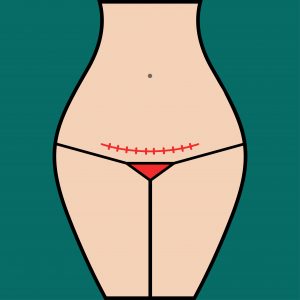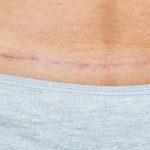
Q: What can i do to my scar to allow it it to be optimum in the future?
A:
1. Time. Allowing yourself adequate time to recover from a csection is a good idea. Remember it can take up to 12 weeks for healing to happen so before pushing things too soon.
2. Silicone strips. If your scar is raised, then trying a silicone strip (Available online) can help to flatten it out over time.
3. Massage. I highly recommend practising self-massage. I asked Cecile Dumont (sort tissue therapist @Fix ) for more advice on the benefits of scar massage. This is her advice below-
“Some scar tissue can be treated as early as 2 hours after the event, some require a couple of years before they can be released, but all scars can be worked on at some point, even at much later stages life. The sooner you start, the better. In the case of a C scar, the NHS guideline is 6 weeks to 3 months.
However, we can start releasing AROUND the scar sooner than that to make room for healing. Before doing any work directly to the scar itself, check in with yourself- are you comfortable placing your hand on the scar? Do you feel ready for this type of work? If not, no worries, wait until you do.
The expression Listening Touch (familiar to all body workers) applies particularly well to the sensitive and delicate nature of scar tissue release- the skin is the interface between our physical self and our environment but it is also an interface between our emotional self and our surroundings. Different C section scars will come with different stories and each mother will have their own unique relationship with the scar. Myofascial Release (MFR) is the best approach to adopt for scars and you can practice it`s basic principles yourself.
When releasing scar tissues- as with all type of body work- it is essential to work with kindness, gentleness and patience. Your body has been though a trauma and the experience will have left traces whether you are conscious of it it or not. We don`t want to take your body through any of it again so it is essential for you to be listening with your fingers and your hands, working gently, and discovering as you go, how to best bring release and relief. You can even start over clothes if you prefer. Good myofascial work is less about the technique, more about the ability for you to tune into your own body and listen with your hands.
In the acute phase of the scarring process (when the scar is still inflamed, red and not healed/sealed), broad and gentle techniques can be used around the site to reduce oedema. Past this acute stage fascial techniques can progressively be introduced across the scar itself to great results.”
Thank you for your wisdom on this subject Cecile !

You can find Cecile @Fix(London Fields, Hackney). just book online via www.fixlondon.co.uk or call to speak to one of our lovely reception team to book on 020 8986 5551


